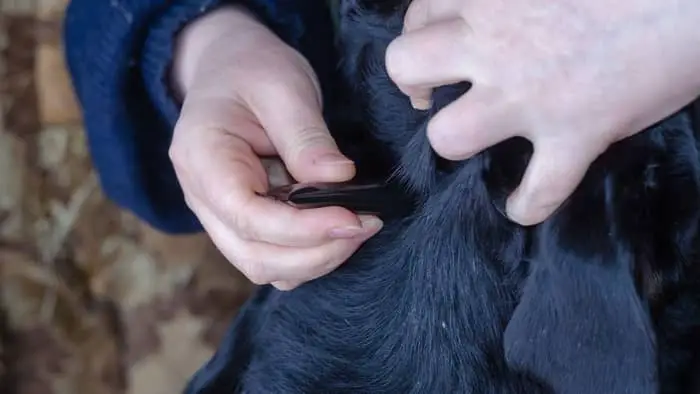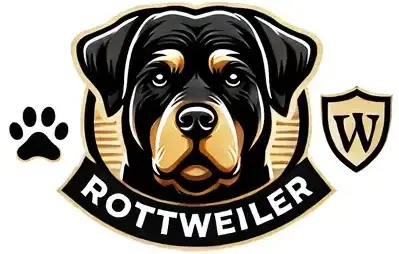Last Updated on April 24, 2024 by Dr. Julie
Have you noticed your dog chew the base of the tail? Allergies, infections, pests, or injuries could be the significant causes of dog tail chewing.
Since dogs do not talk like humans do, they are not able to make their needs known. They try to communicate by showing us where it hurts or where there is discomfort.
It is easy to get frustrated when our dogs engage in repetitive, destructive, or troubling behaviors as a dog owners. Some owners may think it’s a dog’s thing to chase its tail but let’s assure you today that it’s not.
When your dog keeps biting the rear end, it’s a sign to show you there is a pending problem. Let’s look at the reasons that make your dog chase and chew the base of its tail.
Table of Contents
Causes Of Dog Chew Base Of The Tail
The most common causes of dog chewing tail are:
Pests: Fleas, Ticks, Or Worms
Fleas and ticks are common pests that love to afflict dogs. We’ve all seen a dog scratch at a spot on his body, and a flea bounces around, or we notice a tick tightly grasped on the skin.
Treat these pests’ infections using medicated collars, regular baths, and prescriptions. Pests are easy to treat, and once medicated, they will disappear as fast as they came leaving your dog at peace.
If the pest problem is not diagnosed quickly, the pests may repeatedly bite at the same place until they break their skin trying to find relief. Tapeworms could also cause physical discomfort to the area surrounding the anus, with the dog feeling the urge to gnaw chew at the base of the tail.
Generally, its pain causes her to chew, leading to whining in search of relief.

Learn more about: How Much Do Rottweilers Shed? A Very Hairy Guide
Skin and Environmental Allergies
Ticks and fleas cause inflammation of the skin or dermatitis that is caused by fleas. Environmental allergies include pollen from the plants and household chemicals used around the home. Whether the source of your dog’s allergy is household chemicals, mold, mites, or contact with other animals, the reactions are severe, especially between 3 to 6 months old.
Just as a human’s first instinct is to scratch at it, it’s the same for a dog. Interestingly, trying to treat one allergy could easily lead to the discovery of a different one. It is worse if your dog has sensitive skin; something as simple as soaps or shampoos you use on them can spur an allergic reaction.
Injury
Any back part injury that may include a fractured or broken tail bone is enough to cause your dog intense pain and discomfort. The intensity of the pain causes the dog to act by excessive biting, itching, or licking at the affected part. If you cannot diagnose the problem that is causing your dog to bite its butt, consult with the vet asap.
Hot Spots and Other Secondary Infections
A hot spot is on its body where it keeps scratching, biting, or chewing, leading to an open wound. Warmth and moisture are the optimal conditions for hotspots to form, especially before they are infected by bacteria.
The scratching and gnawing can cause a secondary infection to appear at the same point. You can recognize a hotspot by the presence of pus, blood, and matted hair.
If you notice your dog biting at the base of her tail frequently until she draws blood, then secondary infections could be the problem.
A vet will help you determine whether the true reason is nutrition, hygiene, or another factor.
Stress, Boredom, Or Confinement
Stress, anxiety or boredom can lead dogs into a host of destructive behavior. They will go around tearing your shoes, your couch, your pillows, etc. To be safe, some people crate their dogs when they leave home to keep them from destructive behavior. However, if your dog spends too much time confined, they may turn their attentions inward and seek relief where they can.
The same applies to dogs that do not get enough exercise and interactive play. Dogs may turn to destructive activities like tail biting to distract themselves from boredom or to seek attention.
Impacted Anal Glands
A dog has two glands on each side of the anus. The fluids of these glands are a form of dog ID to know each other like dogs. When two stranger dogs meet, you will find them sniffing each other’s rear ends. They are simply obtaining information about the newcomer from the secretions.
Anal glands can become impacted, resulting in possible infection and pain. Tail gnawing and scooting are signs of impacted anal glands. Should you notice any of these signs, take your pet to the vet for an examination.
If they are the problem, your vet can express them and release the nasty material held inside. If it is an infection, you will receive some antibiotics.
Conclusion
Have you noted your dog’s irritation as it chews the base of the tail? As you can tell, the more the dog bites or scratches, the more irritation it keeps getting. You will notice the most affected area is the base of the tail which can be affected by any of the above problems.
But, the good news is all the above problems have a cure that is affordable and easy to use. Start by practicing better hygiene with your dogs and discovering their allergic reactions to soaps or shampoos before developing any secondary infections. It will also help you treat any condition as fast as it appears to keep your dog at peace.
Have you ever had a dog who was constantly chewing the base of the tail? Did you have to see the vet, or did you diagnose it on your own? Were you able to treat it successfully?
Share your experiences with other dog owners so they can know how to deal with this annoying habit.
While some biting can be expected, if you think your dog is going overboard, if your dog is going overboard and has signs of bleeding or infection, it’s best to talk to the vet.
